Your guide to boating, camping, birding, and making the most of Elephant Butte Lake—plus a preview of the 2025 upgrades at Marina del Sur and Dam Site Marina.
Welcome to Elephant Butte, where the Rio Grande widens into New Mexico’s largest reservoir, desert ridges glow in the late-afternoon light, and boaters, birders, and campers gather to enjoy the lake—along with a little history, geology, and live music on the side.
This post has everything you need to plan a visit—from camping and birding hotspots to marinas, hiking trails, and a few fun facts you won’t find in the state park brochure. Whether you’re here to paddle, fish, swim, or just get a sunburn and a few good stories, Elephant Butte’s got you covered.
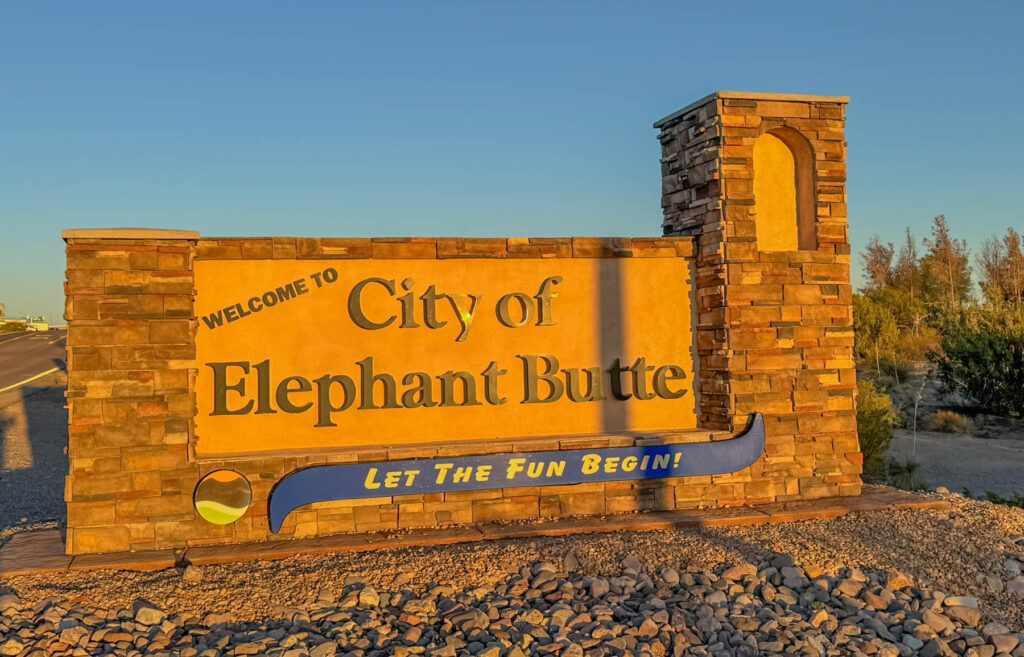
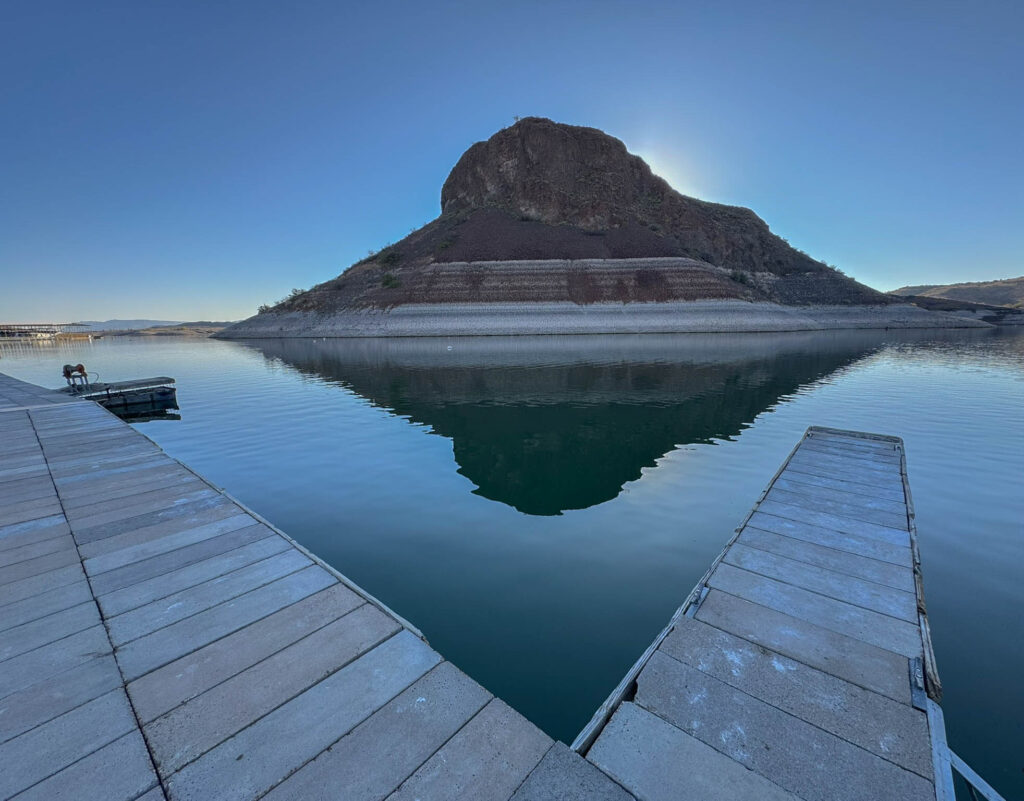
Table of Contents
Heads up: Some of the links in this post are affiliate links. If you buy something through them, it helps support this site—at no extra cost to you. I only recommend stuff I genuinely use and trust.
Where Is Elephant Butte?
Located just northeast of Truth or Consequences (or T or C, if you’re a local), the city of Elephant Butte sits off NM State Road 181. If you’re driving in from Albuquerque, it’s about two hours south on I-25.
Coming from the north, you’ll want the third Elephant Butte exit—the one marked “Elephant Butte Lake State Park” and “Dam Site.” Watch for traffic backing up on summer weekends as boaters and campers make their pilgrimage to the lake. Once you hit the traffic circle and pass the visitor center, you’re in.
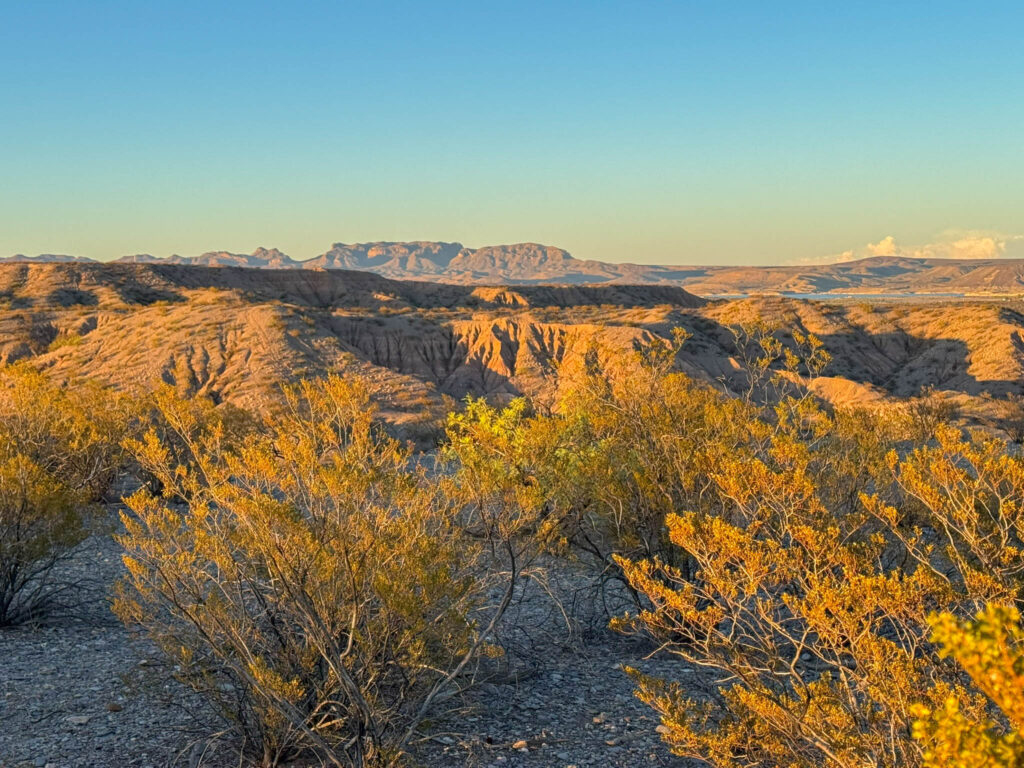
A Quick Look Back at Elephant Butte’s History
Despite the name, Elephant Butte has nothing to do with elephants—and technically, it’s not even a butte. A butte is a steep, flat-topped hill with vertical sides, formed by erosion and usually smaller than a mesa. Elephant Butte, on the other hand, is a volcanic plug—the solidified core of an ancient volcano that now sits just offshore in the lake. Early settlers thought it looked like a reclining elephant. These days, some visitors say it resembles a loaf of bread. Personally, I think it looks like something an elephant might leave behind—after a particularly big lunch. I’ll let you decide from the photo below.

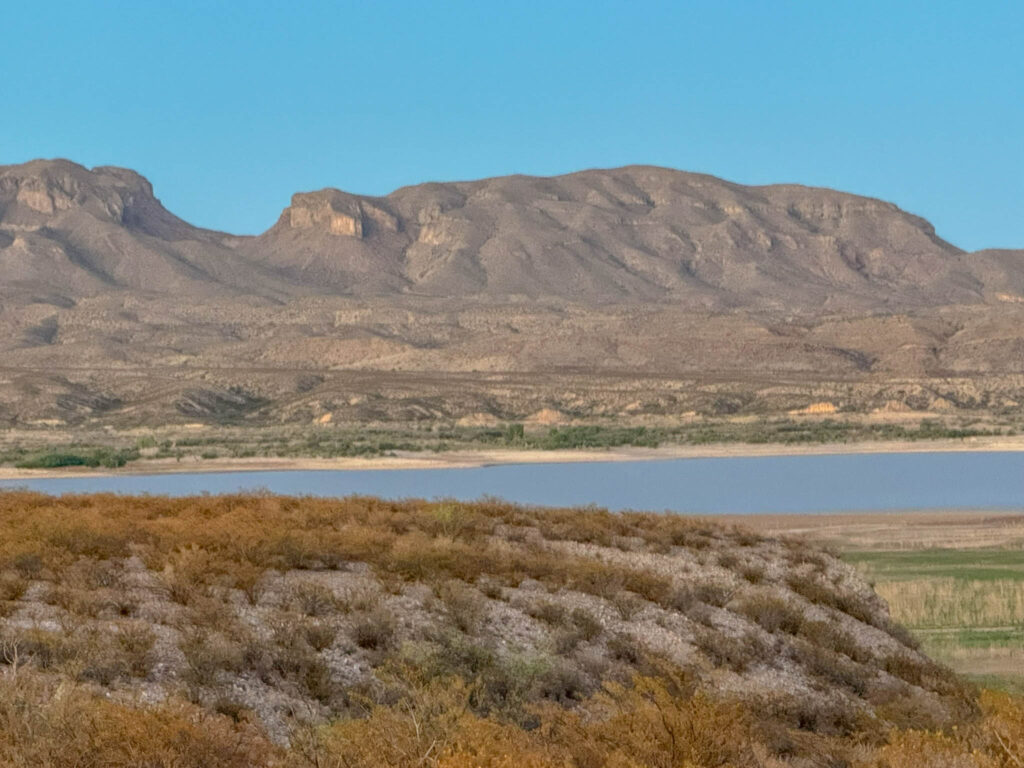
Long before it became a boating hotspot, this area was home to the Mimbres and other ancestral Indigenous peoples who lived throughout the region for centuries. They left behind petroglyphs, tools, pottery, and early irrigation systems—evidence of a deep and enduring connection to the land. The Rio Grande valley provided seasonal resources for farming, hunting, and trade, and it continues to hold spiritual and cultural significance for many Native communities today. Much of that history is still visible—if you know where to look.
Fast forward to the 20th century, when the creation of Elephant Butte Reservoir transformed this stretch of river and desert into a thriving recreational hub. The town of Elephant Butte didn’t officially incorporate until 1998, making it one of the youngest cities in New Mexico. Today, it serves as a seasonal basecamp for boaters, campers, anglers, and snowbirds—especially during the summer months, when the lake becomes one of the busiest inland waterways in the Southwest.
The Story Behind Elephant Butte Dam
Completed in 1916, Elephant Butte Dam was one of the most ambitious engineering feats in the early 20th-century Southwest. Built by the U.S. Bureau of Reclamation, the dam was designed to tame the unpredictable Rio Grande and provide a reliable water supply for agriculture across southern New Mexico, West Texas, and even parts of northern Mexico. When it was finished, it was the largest irrigation project in New Mexico—and, at the time, one of the largest dams in the world. The result was Elephant Butte Reservoir: a 40,000-acre lake with more than 200 miles of shoreline, now used for irrigation, flood control, recreation, and water storage.
The construction itself was no small task. Workers lived on-site in makeshift camps, enduring brutal heat, disease outbreaks, and the occasional dynamite mishap. Narrow-gauge rail lines hauled in materials, and more than 600,000 cubic yards of concrete were poured to complete the structure. Today, you can view the dam from scenic overlooks in the Dam Site Historic District, and nearby walking paths offer excellent views of the reservoir and surrounding terrain. While you can no longer drive across the dam, there are still plenty of ways to take in its scale—and its place in Southwestern history.
But like many big dams of its era, Elephant Butte came with ecological tradeoffs—ones we’re still reckoning with. By cutting off the Rio Grande’s natural flood cycles, the dam disrupted the seasonal rhythms that once nourished cottonwood-willow forests, wetlands, and wildlife-rich riparian zones. The Rio Grande silvery minnow, once abundant, now survives in just 5% of its historic range. The endangered Southwestern Willow Flycatcher—dependent on dense riverside vegetation—has also suffered as its nesting habitat has dwindled.
In response, conservationists and federal agencies have worked to restore sections of habitat downstream, adjust dam releases, and even experiment with managed “pulse flows” that mimic natural flooding. Small steps, but steps in the right direction.
Today, the dam still plays a vital role in the region’s water system and economy—but it also stands as a reminder of how dramatically one project can reshape an ecosystem. Elephant Butte may be a place for sun and recreation now, but it’s also a case study in the ongoing balancing act between human needs and ecological resilience.
If you’re curious to dive deeper into the story behind the dam, check out Elephant Butte Dam by Sherry Fletcher. It’s a photo-rich history of the project, the people who built it, and the early days of life around the reservoir.
For a broader look at the consequences of water engineering across the West, Cadillac Desert: The American West and Its Disappearing Water, Revised Edition by Marc Reisner is an oldie but a goodie. Part history, part cautionary tale, it’s still one of the most eye-opening books you’ll find on how we’ve managed—and mismanaged—water in the American West.
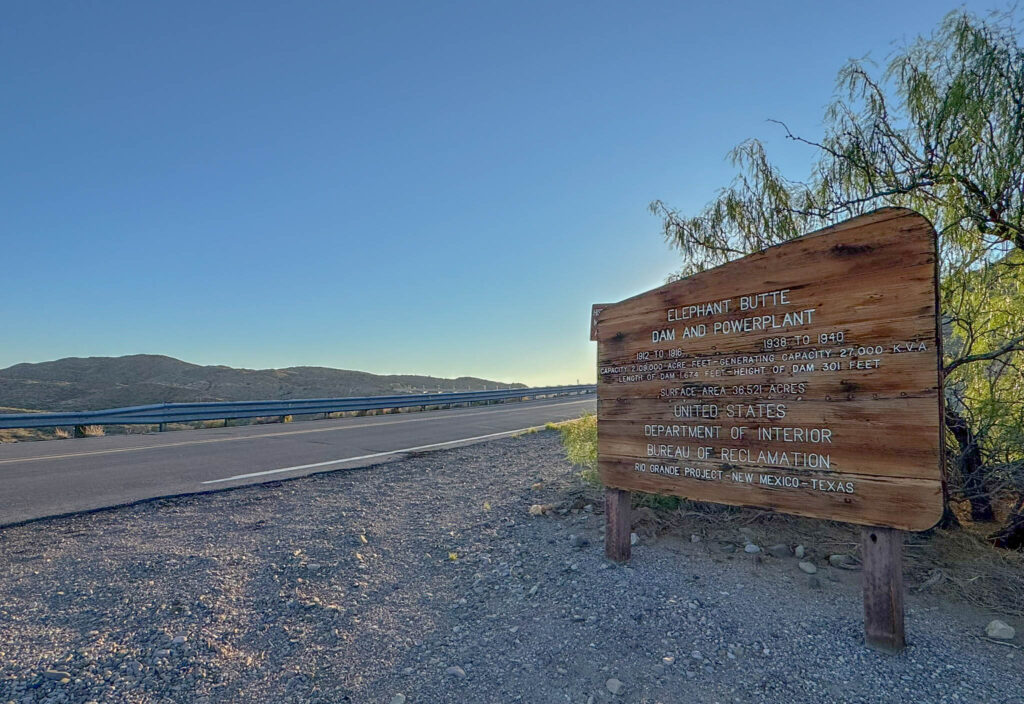
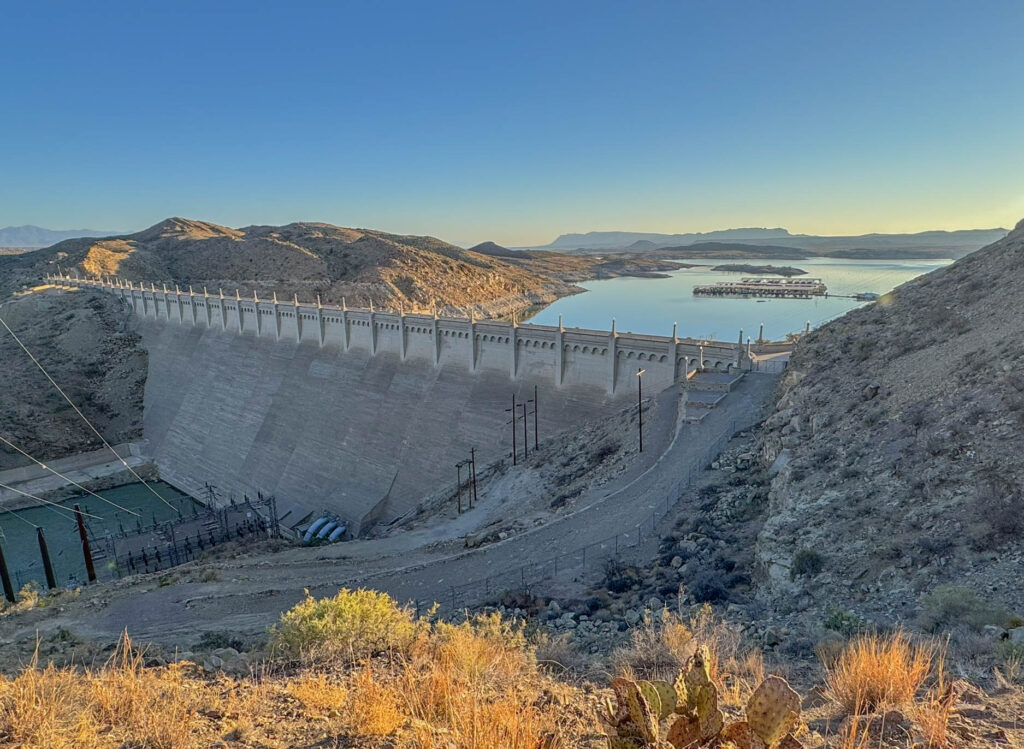
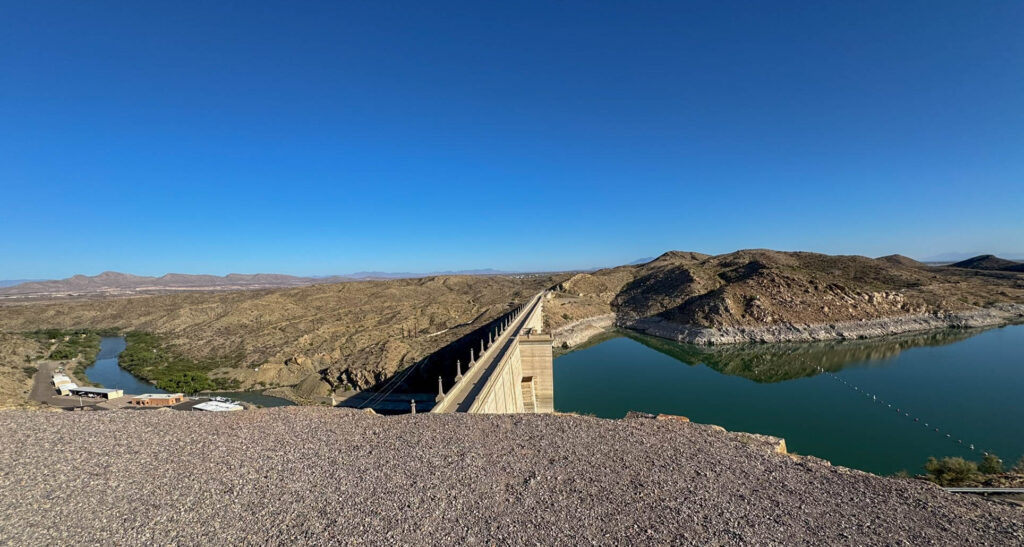
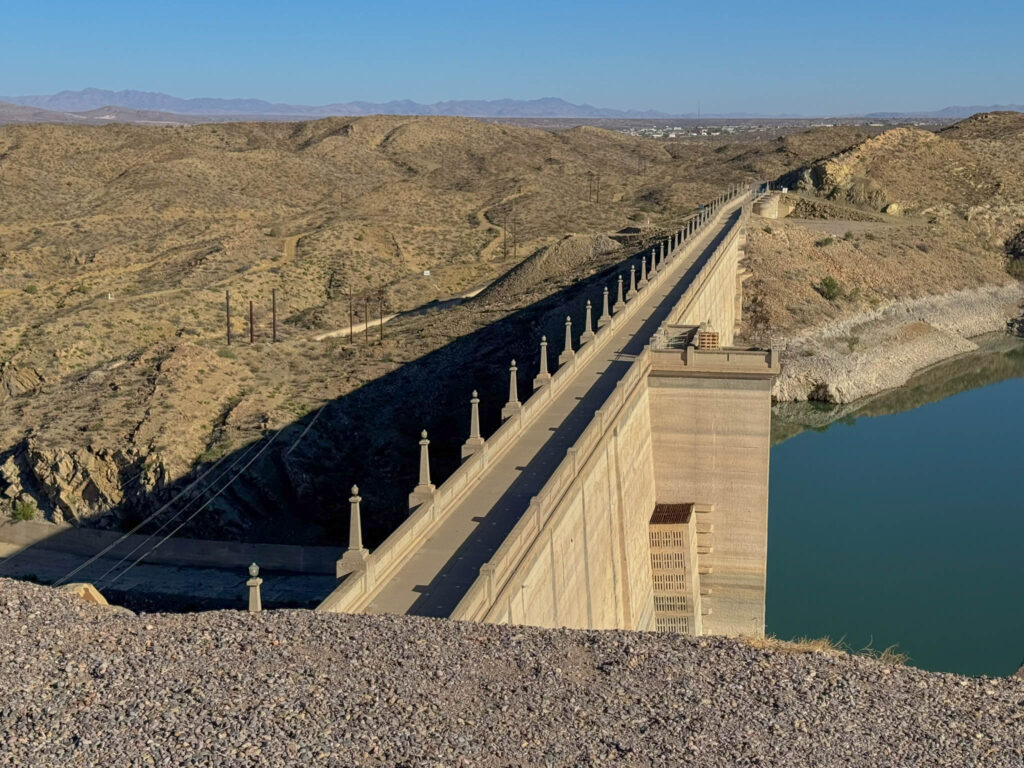
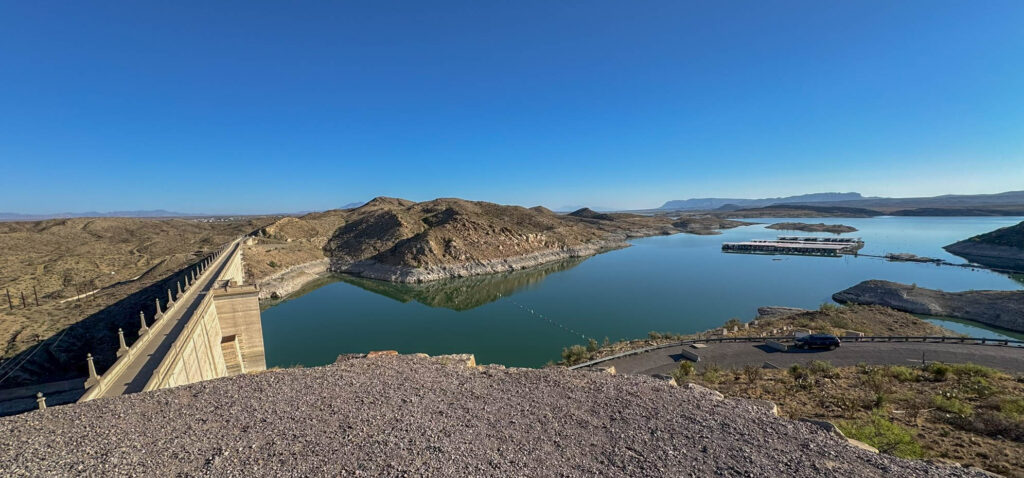
🚤Marinas at Elephant Butte: Boating, Events, and Big Changes Ahead
Elephant Butte has long been one of New Mexico’s go-to spots for boating, but the marinas were getting a little rough around the edges. That’s changing fast.
Thanks to a new ownership group that took over in 2024, Marina del Sur and Dam Site Marina are in the middle of a major refresh. The goal? To turn these marinas from simple boat storage into true community hubs—with better service, upgraded amenities, and a whole lot more fun.
Here’s what’s already underway—and why you might want to start planning your 2025 lake days now.
Marina del Sur: Your Full-Service Launch Pad
Located on the north side of the lake, just inside the main entrance to Elephant Butte Lake State Park, Marina del Sur is the larger of the two marinas and a go-to launch point for boaters, paddlers, and anyone planning to spend a full day—or an entire weekend—on the water.
What’s New (and Coming Soon):
- Upgraded restrooms for slip holders and the public.
- A newly enhanced fuel dock for faster fill-ups.
- An improved store with expanded merchandise and supplies.
- A new rental fleet, including double-decker tritoons (three-tube pontoons) with fully plumbed water slides.
- A growing lineup of live events and music planned for summer 2025.
- With food and liquor licenses in the works, snacks and cold drinks might be just the beginning.
Whether you’re renting a pontoon or launching your own boat, Marina del Sur is quickly becoming more than just a gateway to the lake—it’s becoming a destination in its own right.
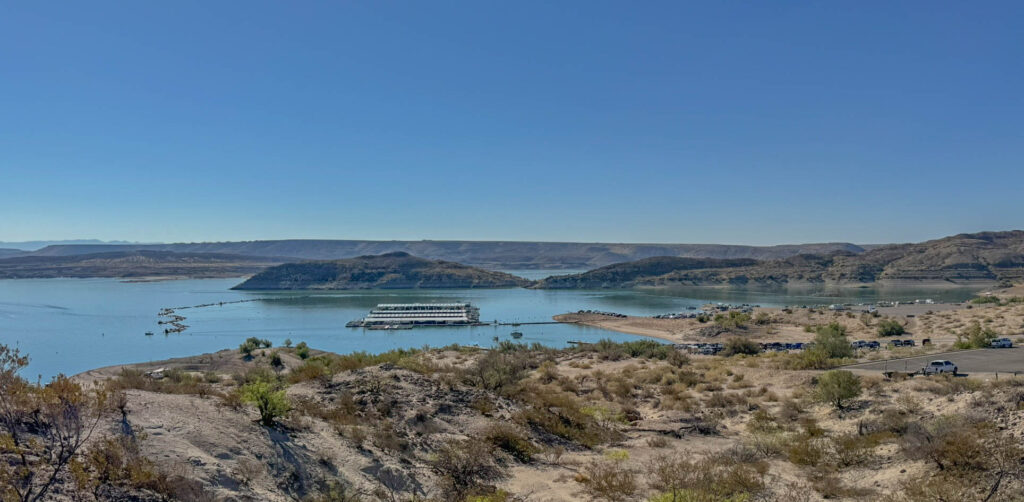

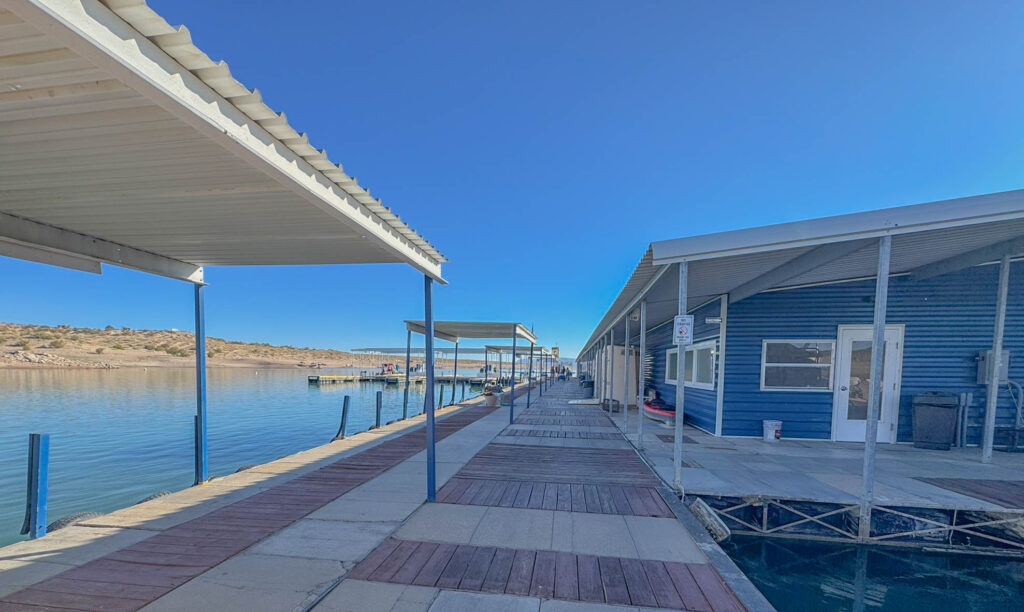

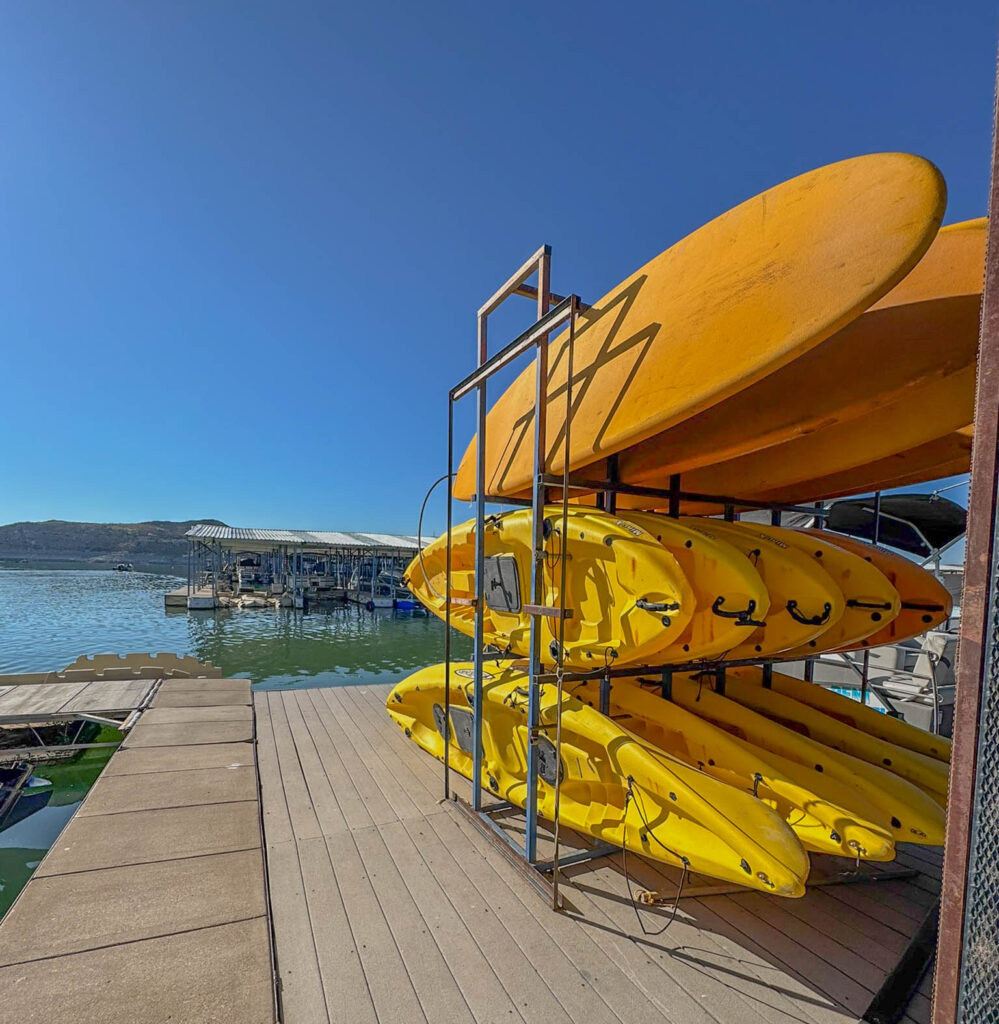
2025 Events & Live Music at Marina del Sur
Planning your summer trip? You might want to time it with one of Marina del Sur’s live events. The new owners are delivering on their promise to turn the marina into a social hub—with dockside music, fireworks, and relaxed, family-friendly gatherings by the water.
Here’s what’s on deck for Summer 2025:
- Friday Night Live – June 13, July 11, August 8 (6:00–8:00 PM)
Unwind with live local music as the sun sets over the lake. - Firework Show – July 5 (6:00–8:00 PM)
Celebrate the holiday weekend with fireworks and music on the marina. - Hot Summer Nights! – July 26 (5:00–8:00 PM)
A casual community event with music, food, and laid-back lake vibes.
All events are free and open to the public. Bring your lawn chairs, your crew, and your sunset-watching skills.
Hot Air Balloons Over the Water
Every year, the Elephant Butte Balloon Regatta fills the sky with color as dozens of hot air balloons launch right over the lake. It’s one of the few places where you’ll see a true splash-n-dash—when pilots dip their baskets low enough to skim the surface before rising again. The 44th Annual Elephant Butte Balloon Regatta is scheduled for August 22-24, 2025.
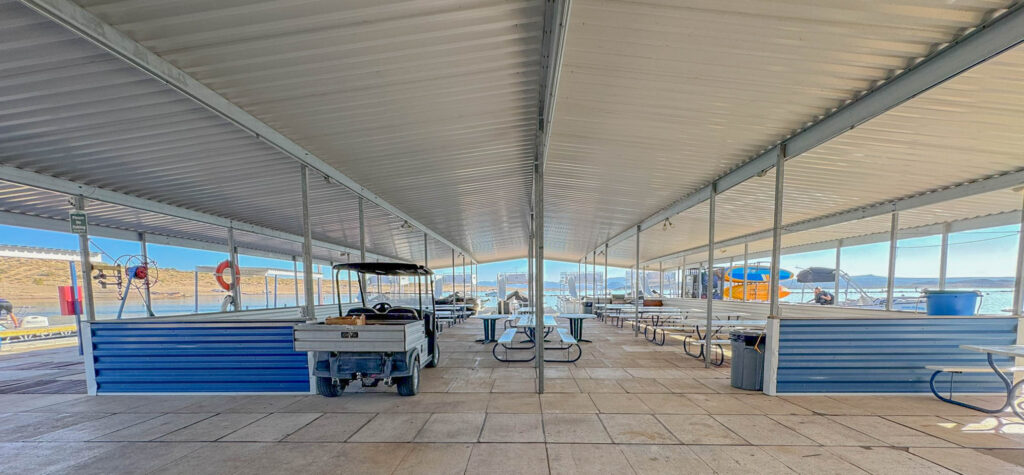
Dam Site Marina: The Quieter Side of the Lake, Steeped in History
Set in the Dam Site Historic District, this marina offers a peaceful escape with canyon views, calm waters, and a glimpse of the past. The nearby historic casitas and stone buildings—once home to dam workers—are being thoughtfully restored and will be bookable on Airbnb and Expedia starting September 2025. Whether you’re craving a quiet retreat or just want to ditch the tent for a comfy bed with a view, these casitas will make it easy to stay close to the lake without sacrificing comfort.
Upgrades for 2025:
- A complete store renovation.
- Expanded fuel access for better convenience.
- New and modernized restroom facilities.
- Fresh signage, painting, and public space upgrades.
- Improved access roads and buried power lines for a cleaner, more sustainable layout.
Whether you’re paddling out at sunrise or winding down with a cold drink and a view, Dam Site Marina is the low-key lake day you didn’t know you needed.
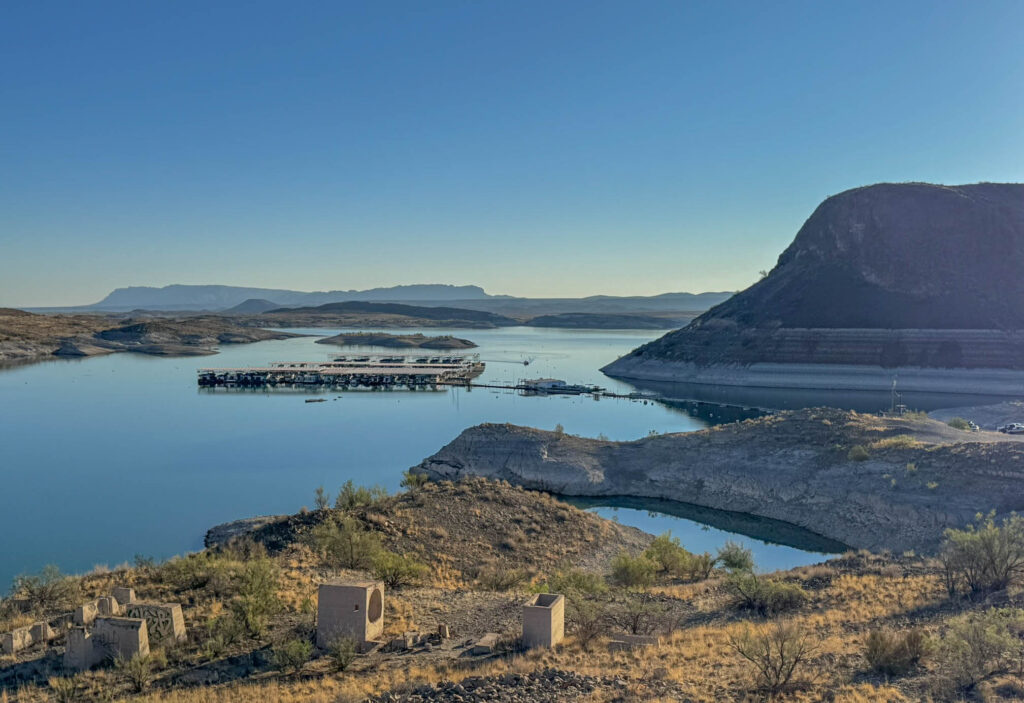
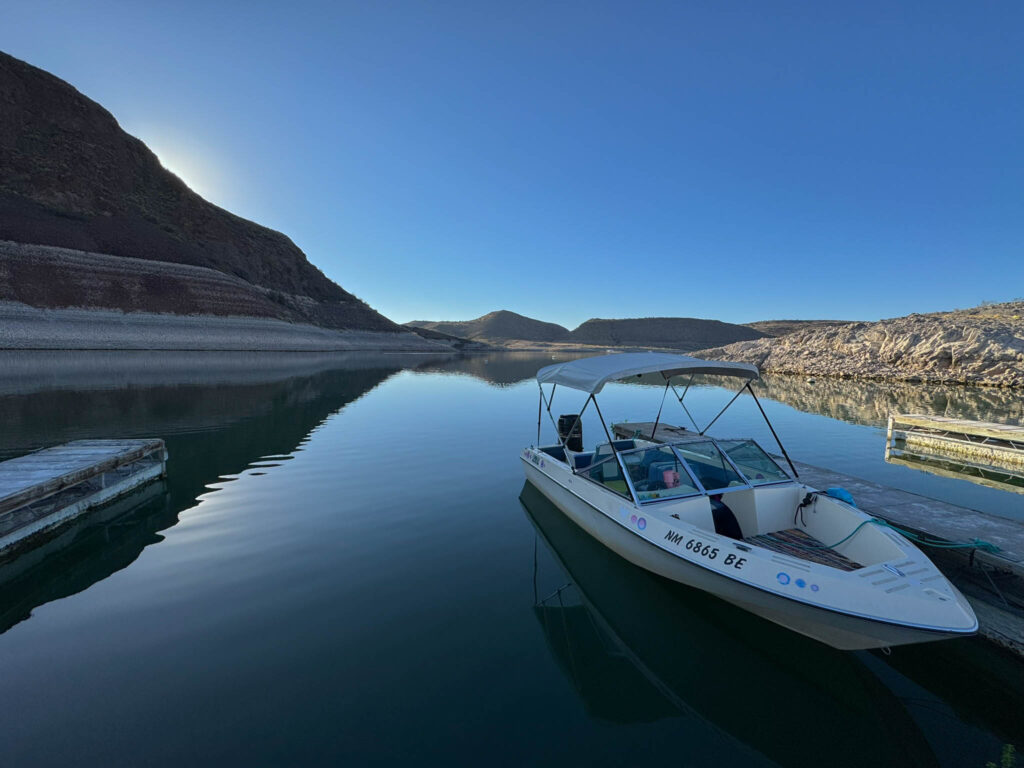
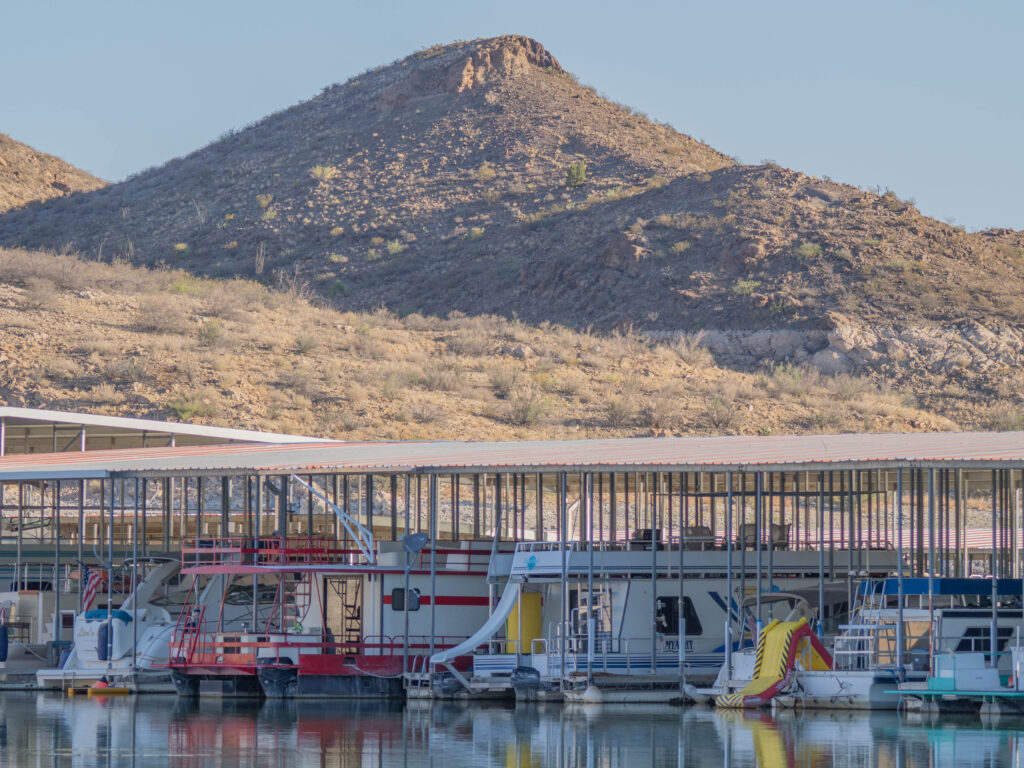
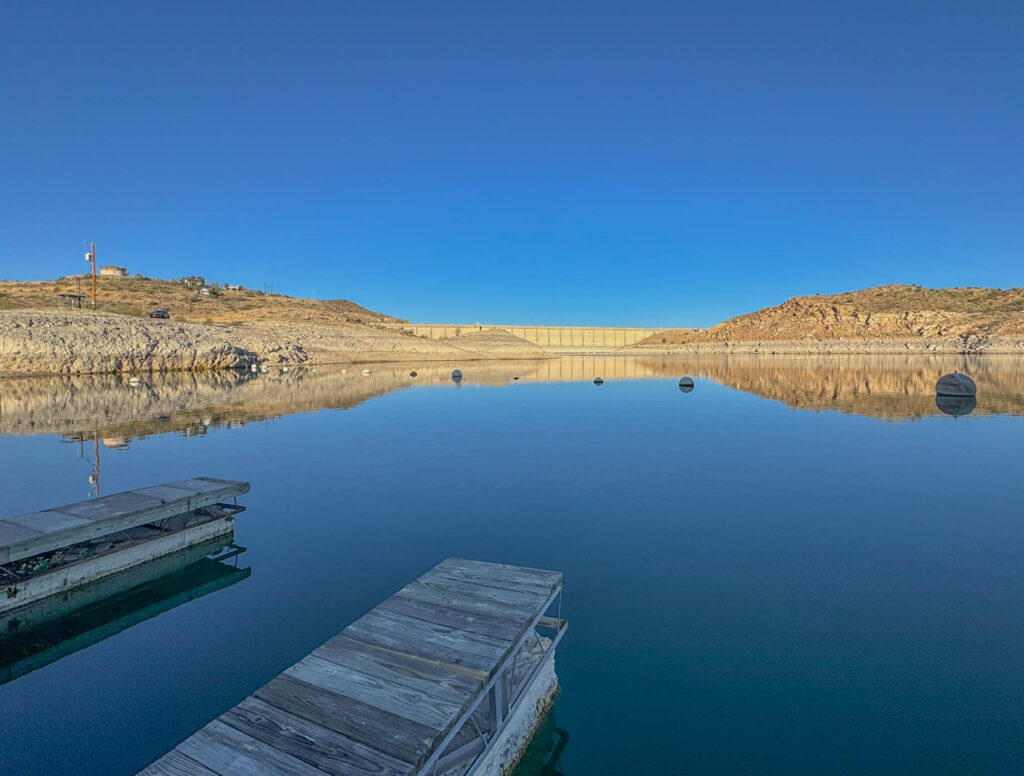
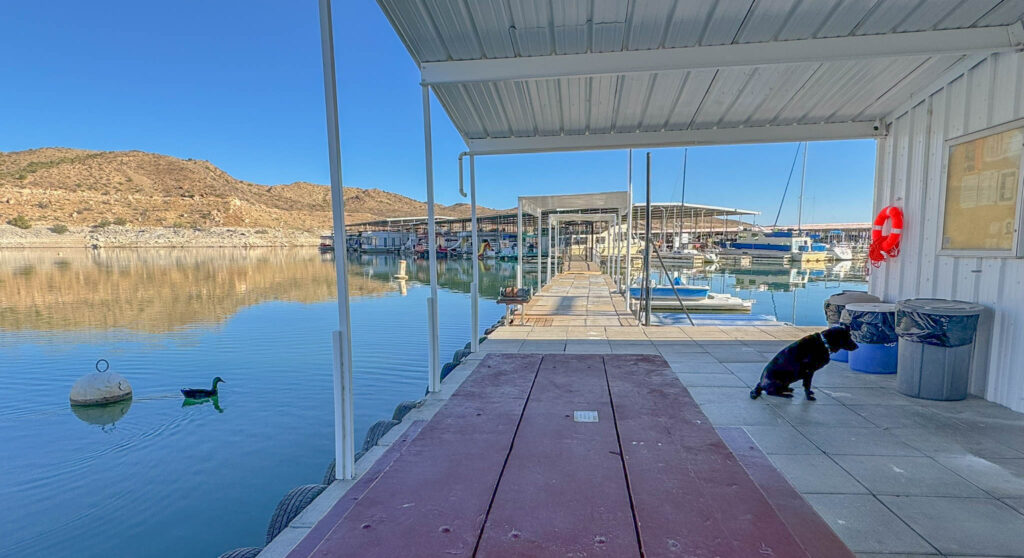

Marinas with a Mission: A New Vision for Lake Life at Elephant Butte
The team behind these upgrades isn’t just slapping on a fresh coat of paint—they’re reimagining both marinas as places where people want to spend time. Think more events, friendlier service, upgraded amenities, and a welcoming atmosphere for everyone from first-time visitors to longtime locals.
Whether you’re here to rent a boat, catch a sunset concert, or just grab sunscreen and snacks for the kids, the marinas aren’t just a convenience anymore—they’re part of the experience.
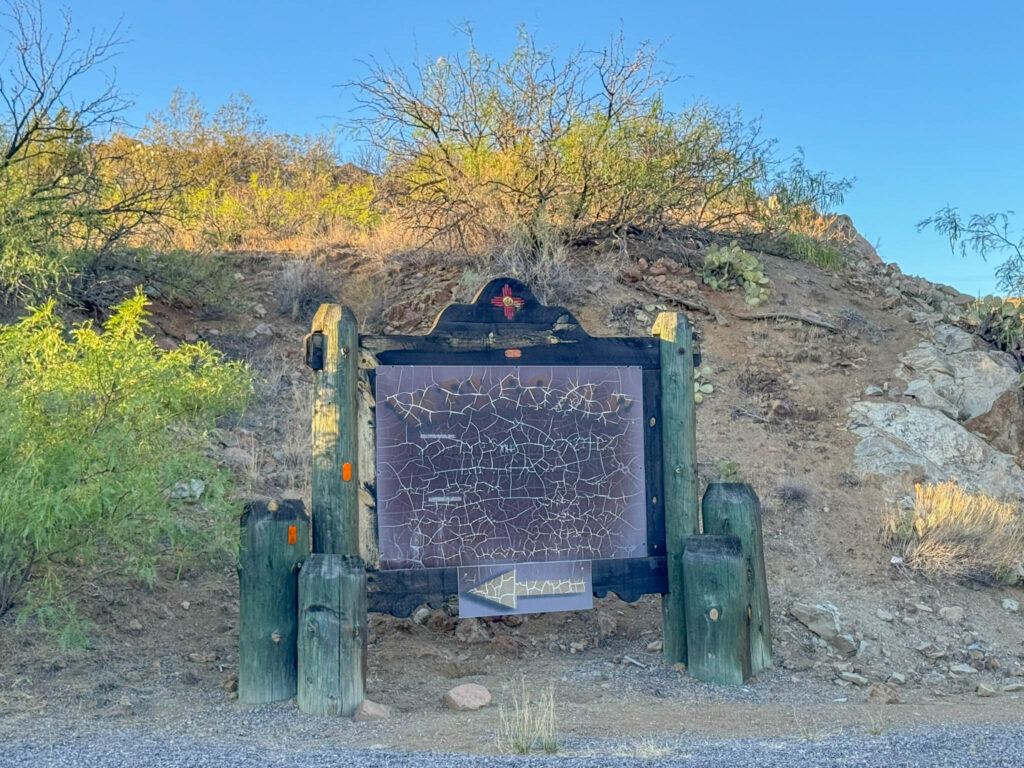
🎣Fishing and Boating Guide: What’s Biting and Where to Launch
Elephant Butte is New Mexico’s most popular fishing lake—and from what I’ve heard, it more than earns that title. I rarely fish myself, but even I could tell things were looking good when I visited. A local told me the lake was recently restocked with 500,000 bass, and I saw plenty of early morning boats heading out with purpose.
What’s in the Water:
- Striped Bass – The big prize here. Some grow to 20+ pounds.
- White Bass – Schooling fish known for topwater action.
- Catfish – Channel and flathead varieties both show up on lines.
- Walleye, Crappie & Bluegill – Popular for families and casual outings.
- Carp – Not often targeted, but massive—and apparently fun on a fly rod.
Tip I heard: Spring and fall are prime seasons for bass. Try trolling in the deeper water near Rock Canyon or bait fishing in the sheltered marina coves—especially early or late in the day.
Where to Launch:
- Marina del Sur – Full-service marina with ramps, rentals, and fuel.
- Dam Site Marina – Great for smaller boats, paddleboards, and kayaks.
- Rock Canyon Launch – Often less crowded and offers easy access to open water.
Heads-up: You’ll need a New Mexico fishing license, available online or at the visitor center.
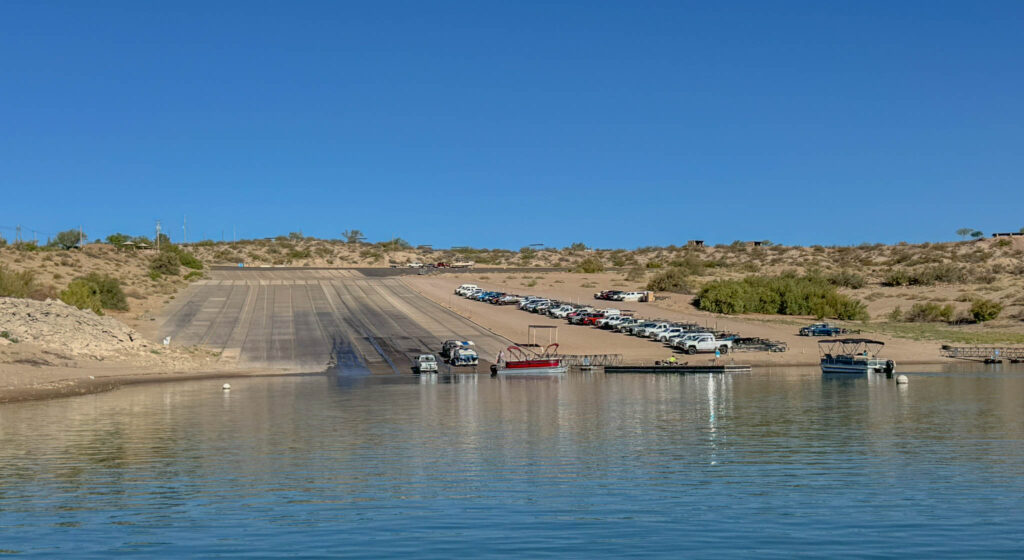
🥾Hiking at Elephant Butte? Where to Wander (or Go All In)
Let’s be honest—if you’re looking to summit a peak or disappear into the backcountry, Elephant Butte probably isn’t your spot. It’s not exactly a hiking destination—but if you’re looking to stretch your legs after a day on the lake (or walk off a breakfast burrito), there are a couple of trails worth exploring. One is 14.6 miles long, the other is 1.5—so that makes your choice pretty easy, depending on your mood, your condition, or how much you plan to eat or drink that evening (or did last night).
West Lakeshore Trail
Don’t let the flat terrain fool you—this trail runs 14.6 miles one way along the western edge of the lake. West Lakeshore Trail is well-marked and easy to follow, but it’s long. Most people tackle it in shorter sections, using one of the multiple access points. Think more “choose your own adventure” than out-and-back epic. It’s popular with mountain bikers and walkers alike, and you’ll get plenty of lake views and desert flora along the way.
Luchini Trail
Much shorter and more digestible, this loop near the Dam Site Historic District features interpretive signs, spring wildflowers, and nice views of the dam and Elephant Butte itself. Luchini Trail is a good leg-stretcher before or after a boat ride—or while someone else wrestles with the boat trailer.
Not world-class hiking, but solid options before hopping back in the boat or kicking back at camp.
🐦 Birding in Elephant Butte: A Hidden Hotspot
You might think Elephant Butte is all about boats and beaches—but it’s also one of southern New Mexico’s top birding destinations. That’s right: come for the fishing, stay for the feathers.
The reservoir and surrounding habitat draw over 300 species of birds throughout the year, especially during spring and fall migrations. It’s a hotspot for waterbirds and desert specialists alike, thanks to the combination of deep water, riparian zones, and open desert.
Best Spots for Birding:
According to The New Mexico Bird Finding Guide by William Howe (a fantastic resource if you’re planning to bird anywhere in the state), Elephant Butte has several reliable hotspots:
- North Monticello Point – Great for waterfowl, including American White Pelican, grebes, cormorants, dabbling ducks, herons, and gulls. It’s also a good spot for spotting rarities during migration.
- South Monticello Point – Known for shorebirds, gulls, and the occasional bald eagle. While camping at South Monticello Campground, I came across Gambel’s Quail, White-winged and Mourning Doves, Lesser Nighthawk, Common Poorwill, Ash-throated Flycatcher, and Black-throated Sparrow.
- Rock Canyon Marina – One of the best wintering gull sites in New Mexico, Elephant Butte hosts large numbers of Ring-billed Gulls, along with occasional Herring and California Gulls—and even the chance of spotting a rarer species if you’re lucky. Just east of the marina near Paseo del Rio Campground, keep an eye out for desert specialists like Cactus Wren, Pyrrhuloxia, Curve-billed Thrasher, roadrunners, quail, doves, Lesser Nighthawk, and Black-throated Sparrow.
- Dam Site Marina Area – Scan the cliffs for peregrine falcons and listen for canyon wrens echoing through the rocks.
The New Mexico Bird Finding Guide provides very detailed directions to the various birding hotspots. Bring binoculars, a camera, and some patience. The variety here is well worth a detour—or even a dedicated trip.

🧐Strange but True: Elephant Butte Tales They Don’t Tell in the Brochure
A Fossil Find at a Bachelor Party
Some bachelor parties end in hangovers. This one ended in a 3-million-year-old elephant fossil.
In 2014, a group of friends hiking through Elephant Butte Lake State Park spotted a strange shape in the dry lakebed. Naturally, they started digging—because what else do you do on a bachelor party hike? Thinking they’d found a woolly mammoth, they sent photos to the New Mexico Museum of Natural History and Science.
It turned out to be a stegomastodon, a prehistoric relative of today’s elephant. Weighing over 1,000 pounds, the skull was one of the most complete ever found. It’s now housed at the New Mexico Museum of Natural History.
The Legend of the Giant Catfish
Fishermen love to swap tales of Volkswagen-sized catfish lurking near the base of the dam—monster bottom-feeders big enough to rattle boats and bend the truth. While no one’s caught a certified leviathan, the largest confirmed catfish hauled from the lake weighed in at 78 pounds. Still a beast—but not quite lake legend material.
Secrets Beneath the Surface
The lake holds more than just oversized fish stories. During drought years, when the water recedes, sunken boats have emerged—more than 40 during a single cleanup effort. In one case, a partially submerged vessel revealed skeletal remains belonging to someone who had been missing for 17 years.
But the most unsettling chapter linked to Elephant Butte isn’t in the lake itself—it’s the story of David Parker Ray, the so-called “Toy-Box Killer,” who lived just outside of town. Ray was a suspected serial killer and a convicted kidnapper and torturer, believed to be involved in the disappearances of several women. He earned the nickname because of a soundproofed trailer he referred to as his “toy box,” where he allegedly held victims captive. Ray was never tried for murder and died of a heart attack in 2002, shortly after his sentencing.
Thankfully, that dark chapter is ancient history. These days, Elephant Butte is all about sunshine, lake days, and good stories—the kind you actually want to remember.
🛏️Where to Stay
Hotels
Coming in from out of town? Most hotels are in Truth or Consequences, but you’ll find a few closer to the Elephant Butte State Park entrance. Check hotel availability near Elephant Butte if camping isn’t your thing.
Future Casitas Near the Dam
Here’s something to look forward to: A local project is underway to restore and rent out historic casitas near the Dam Site—stone cottages originally built for dam workers in the early 1900s.
Set against rugged cliffs, these one-of-a-kind rentals will offer views of the reservoir and easy access to the state park campground, Dam Site Marina, and nearby walking trails.
They’re not ready just yet, but once they are, you can expect a blend of rustic character and modern comfort—think thick stone walls, simple finishes, and porch chairs with a view.
Want to be among the first to stay in the historic casitas? Keep an eye out for updates in 2025—they’re expected to be bookable on Airbnb and Expedia once renovations are complete.

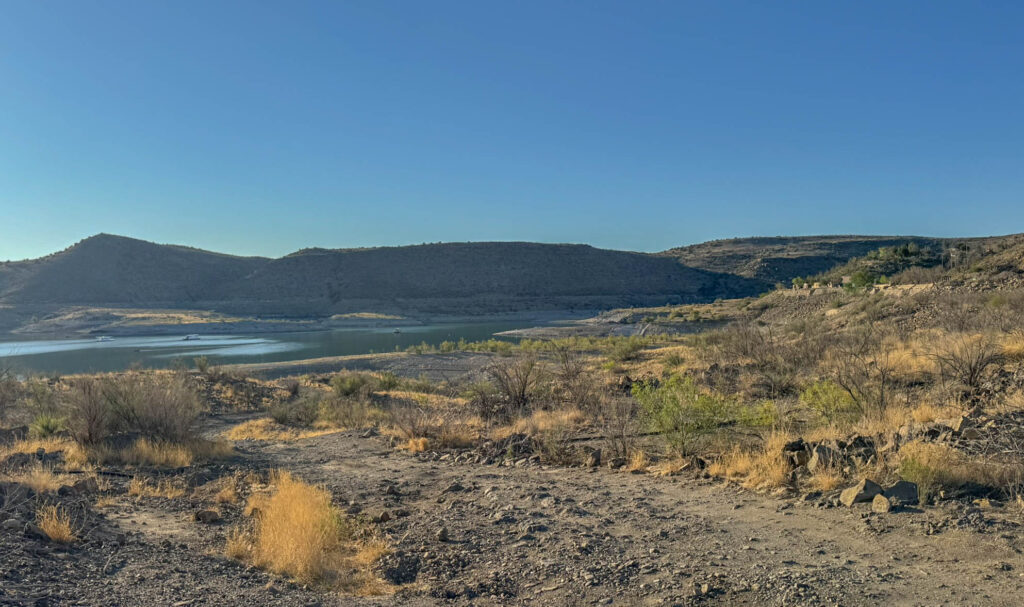
Camping: From State Parks to Quiet Coves
Camping options around Elephant Butte range from well-developed RV parks to dispersed sites on dirt roads where cattle guards rattle under your tires and coyotes howl in the distance. Here’s a breakdown:
1. Elephant Butte Lake State Park Campgrounds
This is the main hub, offering dozens of developed campsites with restrooms and electric hookups. Sites are spread across several peninsulas and coves, including Ridge Road Campground, Rock Canyon, and South Monticello Campground. Be sure to check the New Mexico State Parks website for the latest updates on campground openings and conditions.

South Monticello Campground: I made the rookie move of checking in at the main Elephant Butte State Park entrance—only to find out I could’ve saved myself some time by heading straight to the campground. South Monticello is about 20 minutes north of the main entrance, and you don’t need to stop at the visitor center. Just check in with the campground host or use the self-pay station when you arrive.
If you roll in late, head straight to your site and check in with the host or ranger the next morning. It’s a quiet, remote spot—a favorite for stargazing—and it’s where I ended up camping. Your campsite may or may not be close to the water, depending on lake levels. When I visited, there was no lake access at South Monticello due to low water, so plan accordingly.
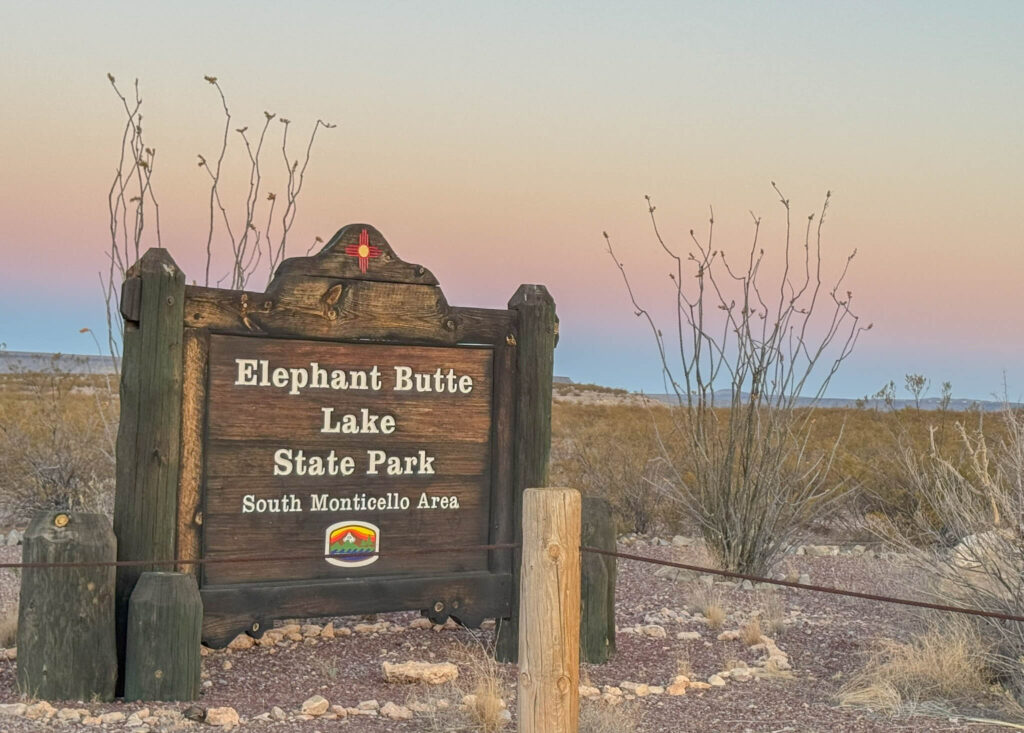
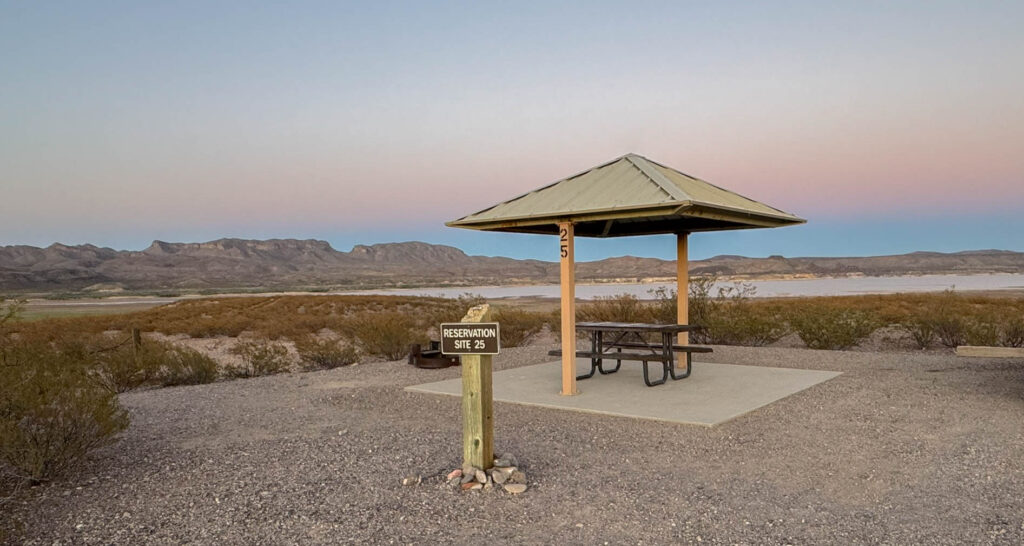
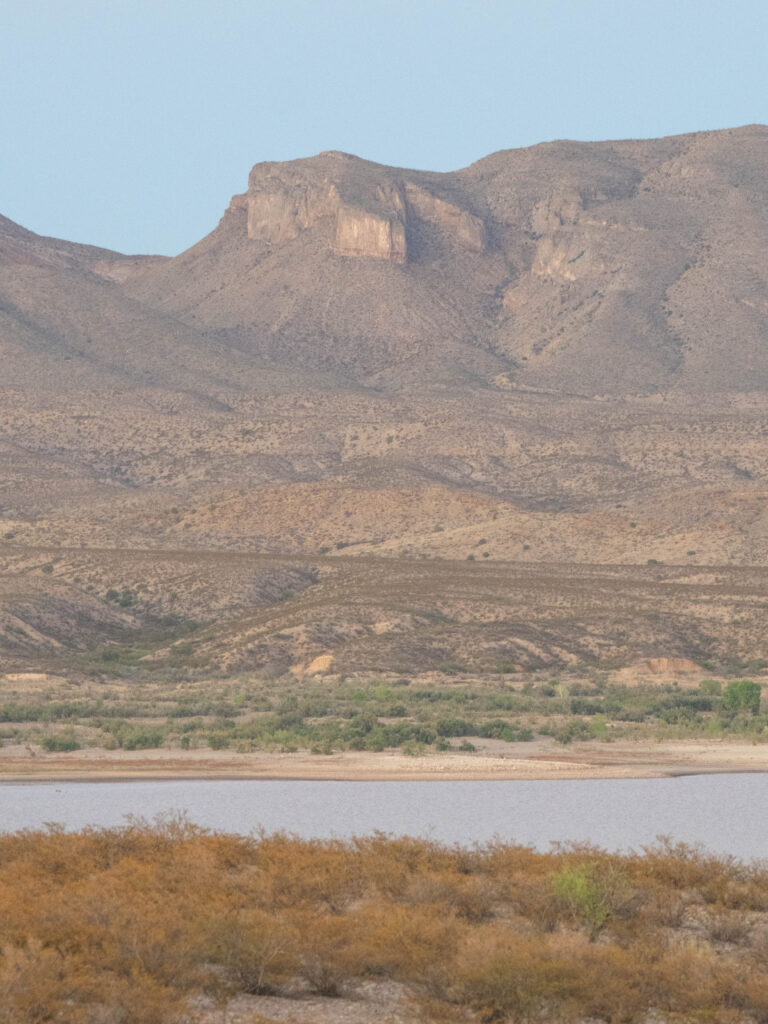

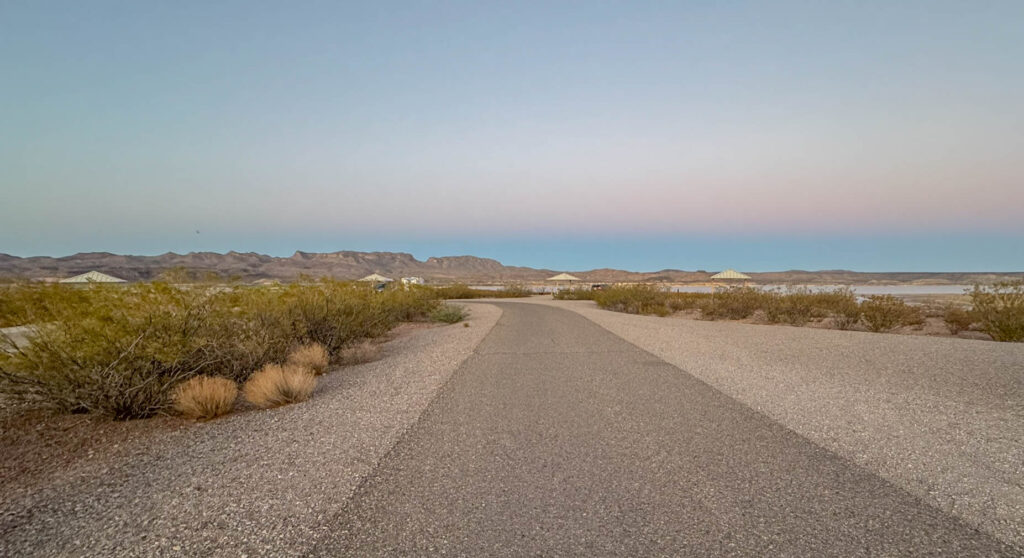

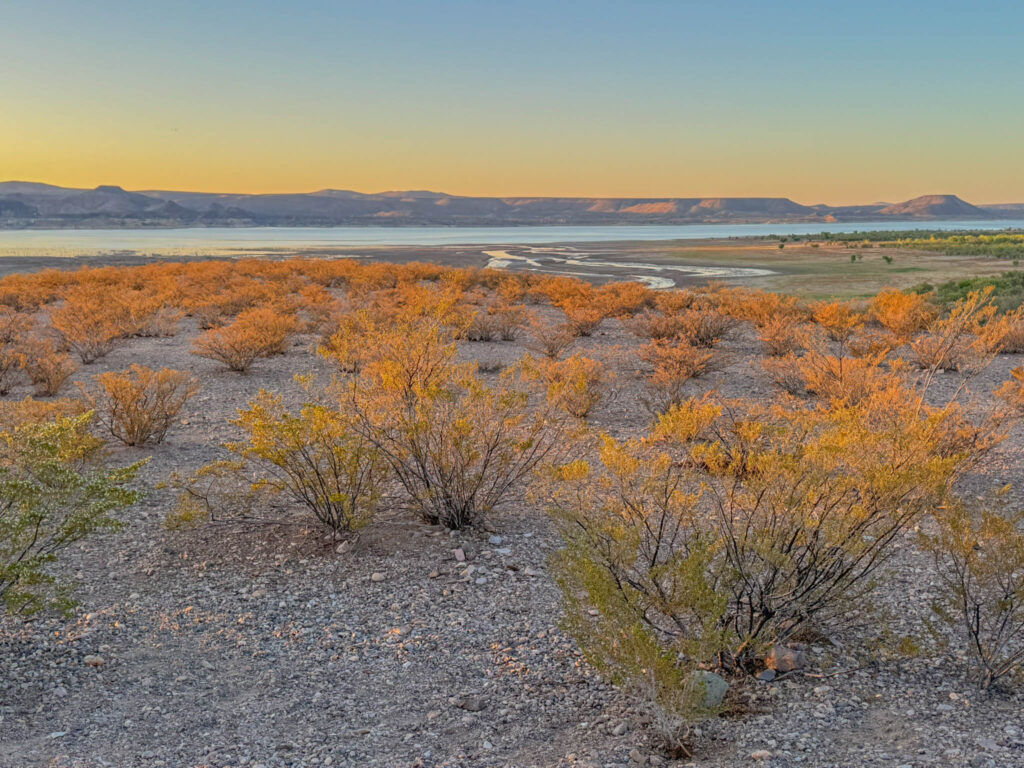
2. Privately Owned Monticello RV Park
Located about ten miles north of Elephant Butte and two miles west of South Monticello Point, Monticello RV Park offers 50 sites—all equipped with 30/50 amp hookups—as well as on-site RV and boat storage.
3. Primitive Camping
Looking for solitude? Dispersed camping—aka primitive or boondocking—on public land is allowed along dirt routes like Martin Ranch Road and through Monticello Canyon. You won’t find amenities like restrooms or trash service, but you also won’t find crowds. Just pack it in, pack it out, keep an eye out for flash flood hazards, and follow any fire bans in effect during high-risk periods.
📚 Further Reading: Books on the Rio Grande
Looking to go deeper into the landscapes, culture, and geology surrounding Elephant Butte and the Rio Grande? Here are a couple of standout books to check out:
- Great River: The Rio Grande in North American History – by Paul Horgan. Winner of both the Pulitzer Prize and Bancroft Prize, this sweeping two-volume work (combined into one paperback) traces the story of the Rio Grande from prehistoric cultures to Spanish expeditions, Mexican independence, and the U.S. frontier. Horgan blends deep research with novelistic storytelling, covering not just the river’s geography but the lives, conflicts, and cultures it shaped along the way. A dense read, yes—but for those who want the definitive historical account of the Rio Grande, this is it.
- Rio Grande: A River Guide to the Geology and Landscapes of Northern New Mexico (Waterproof Edition) – by Paul W. Bauer. Equal parts river guide and geology lesson, this waterproof, spiral-bound book covers 153 miles of the Rio Grande—from Lasauses, Colorado to Cochiti Dam, New Mexico. It’s divided into 11 river stretches, including well-known whitewater sections like the Taos Box, Racecourse, and White Rock Canyon. Full-color maps (based on aerial photos) make it easy to spot landmarks, while the accompanying text highlights everything from canyon formation to paddling difficulty. Whether you’re a kayaker, geology buff, or just like knowing what you’re looking at, this guide has you covered—literally. It’s waterproof.
Final Thoughts
Whether you’re drawn by the boats, birds, or big-sky sunsets, Elephant Butte Lake State Park is one of those places that surprises you—especially if you think of New Mexico as just high desert and chile peppers.
With deep engineering roots, rich wildlife, and evolving attractions like future casita rentals and live music events, Elephant Butte is more than just a lake.
You can fish for striped bass, hike a canyon trail, cool off at a sandy beach, and catch live music at the marina—all in a single day.
And if you’re like me, you’ll leave a little dusty, maybe a little sunburned, and already plotting your return trip.
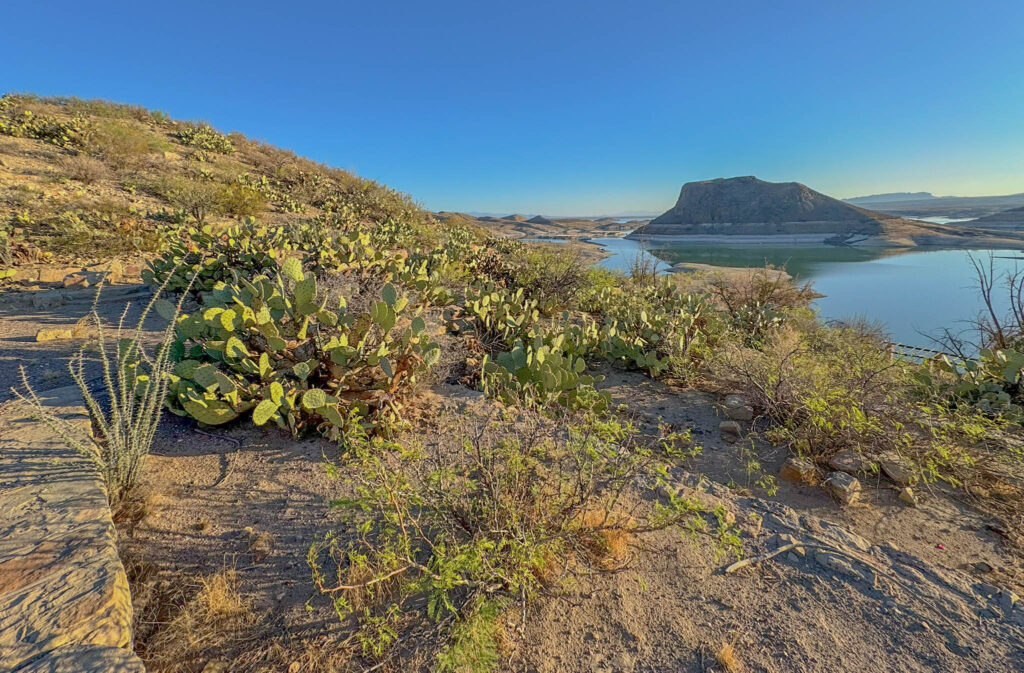
Thought for the Week
This week’s “Thought for the Week” comes from Henry David Thoreau—naturalist, writer, and unofficial patron saint of quiet reflection. He’s best known for Walden, where he documents his time living simply in the woods near a small pond in Massachusetts… while making the rest of us feel mildly guilty for having regular jobs and regular lives, thanks to lines like: “The mass of men lead lives of quiet desperation.”
This week’s quote, also from Walden, is a little less accusatory—but still has a subtle barb. It resonates with anyone who’s been hooked on fishing, birding, peak bagging, or any other focused pursuit. Sometimes, it’s not really about catching the fish, spotting the bird, or reaching the summit. It’s about the feeling that comes with doing it—the rhythm, the focus, the stillness in a world that rarely stops moving. And sometimes, it’s about who we’re with: a shared trail, a quiet morning on the lake, or a good conversation with someone we care about.
So the next time we find ourselves frustrated—missing the fish, the bird, or turning back just shy of the summit—we can remember: that probably wasn’t the real reason we were out there anyway. And chances are, we’ll be back out there soon, trying again—maybe for the fish, maybe for something else.
“Many men go fishing all of their lives without knowing it is not fish they are after.”
— Henry David Thoreau
Thanks for reading and happy travels!
Mark (The New Mexico Travel Guy)

Mark Aspelin, The New Mexico Travel Guy (www.newmexicotravelguy.com), is a travel writer, conservation biologist, project manager, and author of two books. He’s visited over 100 countries and all 50 U.S. states—just enough to land in the Travelers’ Century Club and make choosing a favorite place nearly impossible. He’s currently on a questionable mission to visit every town in New Mexico (there are over 500) and write a story about each one, with plans to wrap it up sometime before his early to mid-100s. Mark balances his writing with conservation and project work from his home base in the East Mountains near Albuquerque, New Mexico.

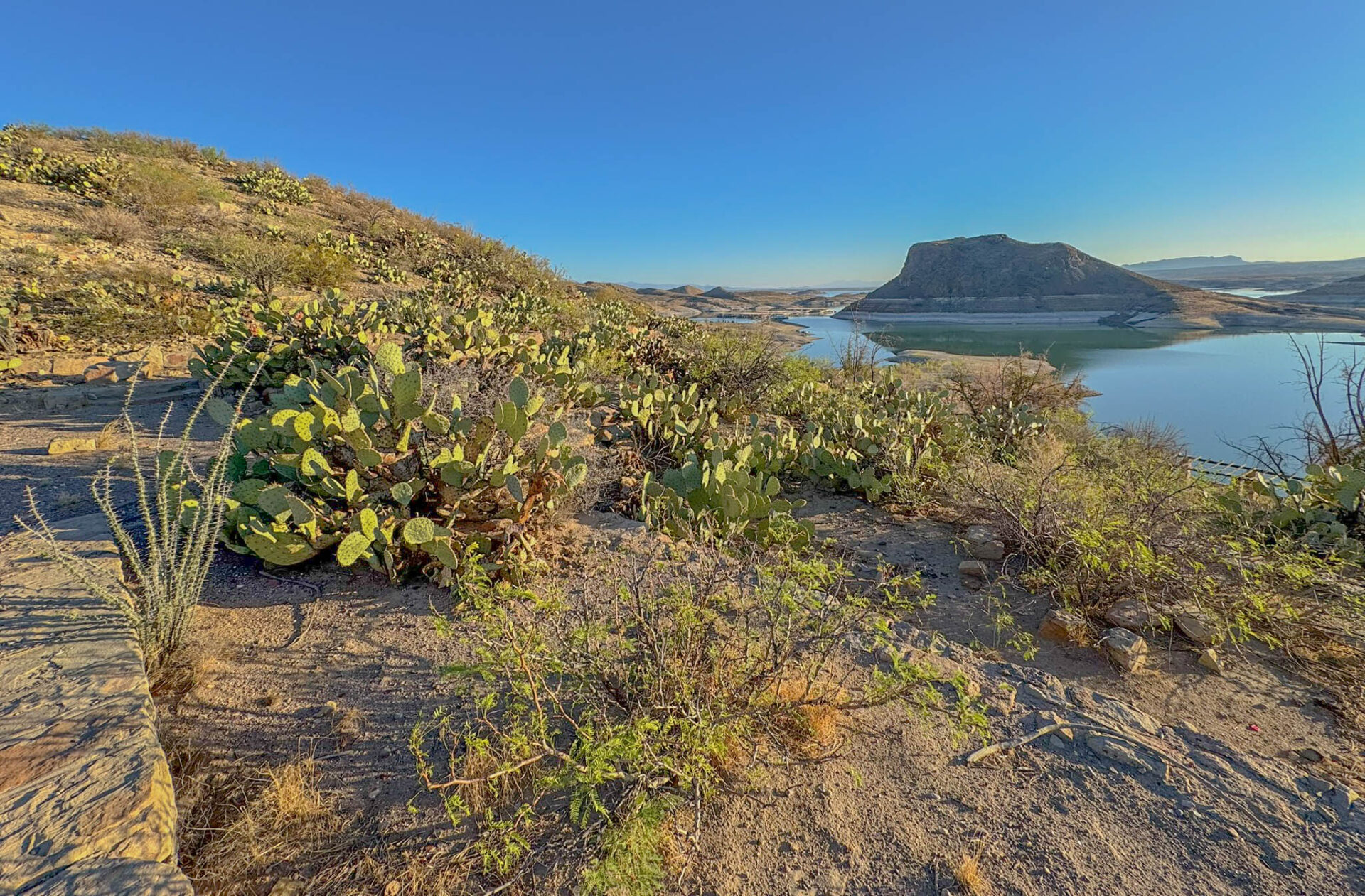



Leave a reply